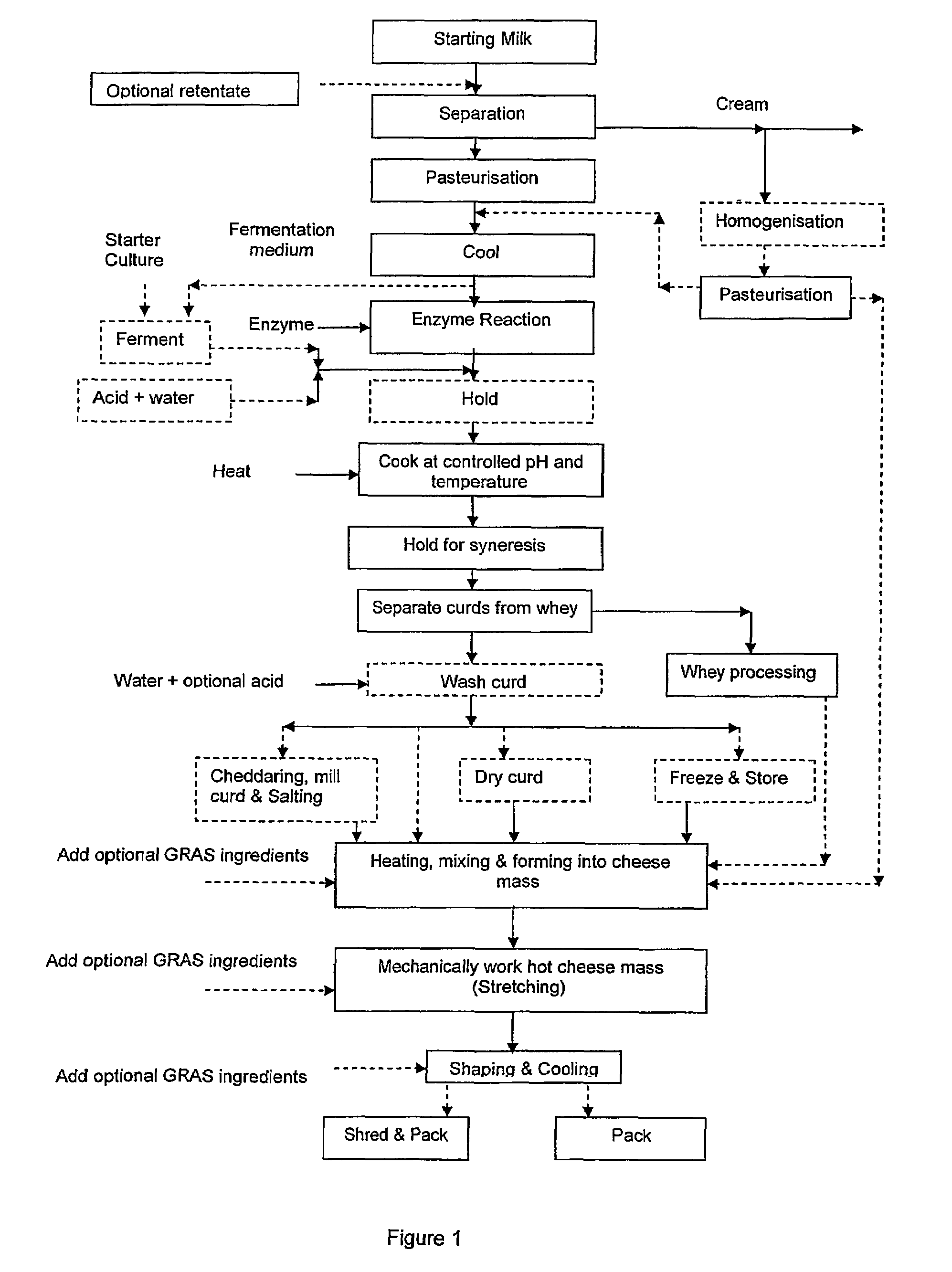Dairy product and process
a dairy product and process technology, applied in the field of dairy products and processes, can solve the problems of affecting the compositional and functional characteristics of the final cheese may not meet the standards acceptable by the industry or consumer, and achieve the effects of reducing the calcium content, improving the functional and compositional characteristics, and improving the consistency of the produ
- Summary
- Abstract
- Description
- Claims
- Application Information
AI Technical Summary
Benefits of technology
Problems solved by technology
Method used
Image
Examples
example 1
[0069]Approximately 1800 L of skimmilk was pasteurized and then cooled to 8 to 10° C. before rennet was added (100 ml). The renneted milk was left to stand overnight for approximately 16 hours at 10° C. Dilute sulphuric acid was then added to the cold renneted milk, in-line immediately prior to cooking, to reduce the pH to pH 5.4. The mixture was heated by direct steam injection at 42 to 44° C. and held for 50 seconds in holding tube. The coagulated cooked curd particles were separated from the whey using a screen, washed using acidified water (8.3 L water, pH 2.6, dilute sulphuric acid / 1 kg curd) and separated from the wash water using a decanter. After dewatering the curd was frozen for later use.
[0070]On thawing the aggregated curd was milled and partially dried using a ring drier to 48% moisture. Salt (0.2 kg), high fat cream (7 kg), 0.272 kg of lactic acid (16% solution) and flavours were added to 7 kg of milled and partially dried curd.
[0071]The flavours comprised a mixture of...
example 2
[0076]Approximately 1800 L of skimmilk was pasteurized and then cooled to 10° C. before rennet was added (100 ml). The renneted milk was left to stand overnight approximately 16 hours at 10° C. Dilute sulphuric acid was then added to the cold renneted milk, in-line immediately prior to cooking, to reduce the pH to pH 5.4, and the mixture heated by direct steam injection at 42 to 44° C. and held for 50 seconds in a holding tube. The coagulated curd particles were separated from the whey using a screen, washed using acidified water (8.3 L water, pH 2.6, dilute sulphuric acid / 1 kg curd) and separated from the wash water using a decanter. After dewatering the curd was frozen for later use.
[0077]On thawing the coagulated curd was milled and partially dried using a ring drier to 49% moisture. Salt (0.265 kg), high fat cream (6.25 kg), 0.272 kg of lactic acid (16% solution) and flavours were added to 7 kg of milled and partially dried curd.
[0078]The flavours comprised prepared concentrated...
example 3
[0084]Approximately 1800 L of skimmilk was pasteurised and then cooled to 8 to 10° C. before rennet was added (100 ml, i.e. 55 ml / 1000 L). The renneted milk was left to stand for approximately 16 hours at 8 to 10° C. After 16 hours dilute sulphuric acid was added to the cold renneted milk, in-line immediately prior to cooking, to reduce the pH to pH 5.3 and the mixture heated by direct steam injection at 42° C. and held for 50 seconds in a holding tube.
[0085]The coagulated curd particles were separated from the whey using a screen and washed using acidified water (8.3 L water, pH 2.6, dilute sulphuric acid / 1 kg curd). The washed coagulated curd particles, with a moisture content of about 52%, were separated from the wash water using a decanter. After dewatering the curd was milled. Salt (0.2 kg), water (2.0 kg) and high fat cream (4.0 kg) were added to 7 kg of milled curd.
[0086]The curd and ingredients were blended according to the procedure given in Example 1, with the exception th...
PUM
 Login to View More
Login to View More Abstract
Description
Claims
Application Information
 Login to View More
Login to View More - R&D
- Intellectual Property
- Life Sciences
- Materials
- Tech Scout
- Unparalleled Data Quality
- Higher Quality Content
- 60% Fewer Hallucinations
Browse by: Latest US Patents, China's latest patents, Technical Efficacy Thesaurus, Application Domain, Technology Topic, Popular Technical Reports.
© 2025 PatSnap. All rights reserved.Legal|Privacy policy|Modern Slavery Act Transparency Statement|Sitemap|About US| Contact US: help@patsnap.com

